Excerpts from Jim Conrad's
Naturalist Newsletter

from the May 10, 2015 Newsletter issued from Río Lagartos, on the Yucatan Peninsula's northern coast (~N21.60°, ~W88.16°), Yucatán state, MÉXICO
MYRMECOPHILA ORCHIDS
In the mangroves nowadays here and there clusters of pretty flowers wave in the wind atop slender, six-ft-tall (2m) peduncles arising from clusters of green, succulent plants growing epiphytically on mangrove branches, as shown below:
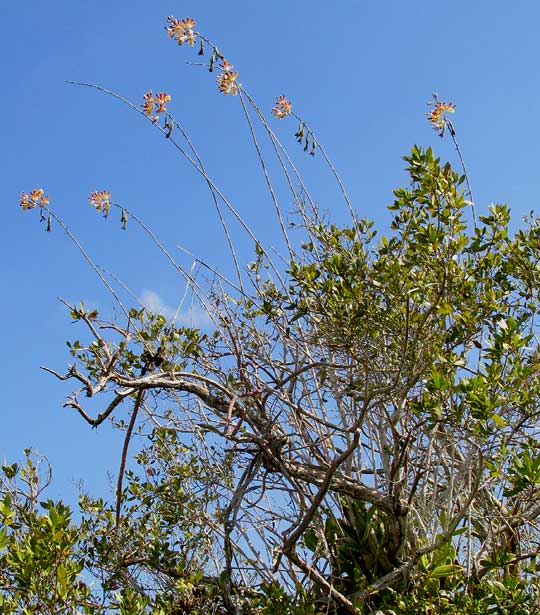
We've seen this before, deep in the mangroves along the Yucatan Peninsula's Caribbean coast north of Mahahual {see entry below}, so already we know that this is MYRMECOPHILA CHRISTINAE, a giant orchid endemic just to the Yucatan Peninsula and parts of Belize and northern, lowland Guatemala.
Something special about Myrmecophila orchids -- of which three species are listed for the Yucatan Peninsula -- is that normally in Nature ants live symbiotically in them. Myrmecophila orchid leaves arise from atop banana-like "pseudobulbs," which are stems modified for water storage. Ants dig chambers in the pseudobulbs, where they live. Below, you can see this orchid's ridged pseudobulbs below their flat leaves:
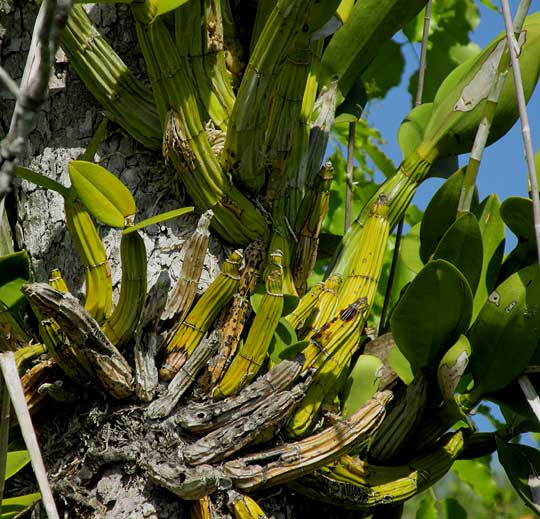
The orchid also provides ants with nectar. In exchange, the ants attack herbivores that disturb the orchids. Also, studies of another species of the genus, Myrmecophila tibicinis, find that ants pack many pseudobulbs with debris that includes dead ants and other dead insects, pieces of plant material, seeds and soil. When this material disintegrates, minerals and other nutrients diffuse from it into the orchid body -- important in such a nutrient-poor environment as tree stems suspended well above the ground. Myrmecophila orchids can survive without ants, though it's rare to find them uninhabited in Nature.
Earlier when we encountered this orchid north of Mahahual, it was hard to get to the plants for a close look. This time better pictures were possible. Below you can see both flowers and fruits atop their tall peduncle:
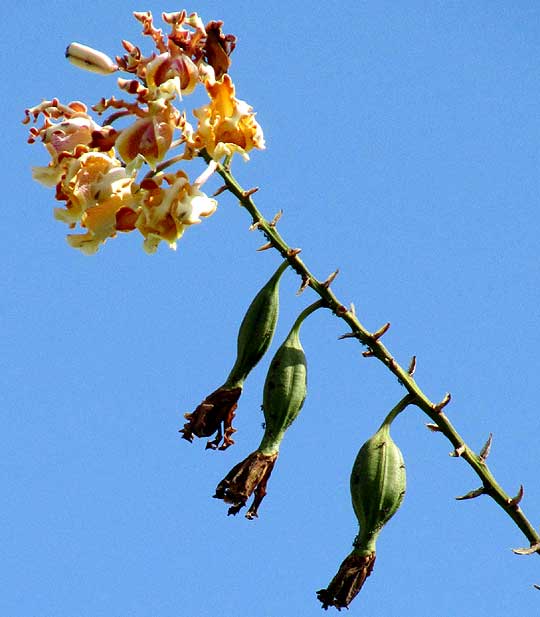
A close-up frontal view of an ant-attended flower is shown at the top of this page. A side view of a fresher flower with its lip fully extended to serve as a landing platform for pollinators is shown below:
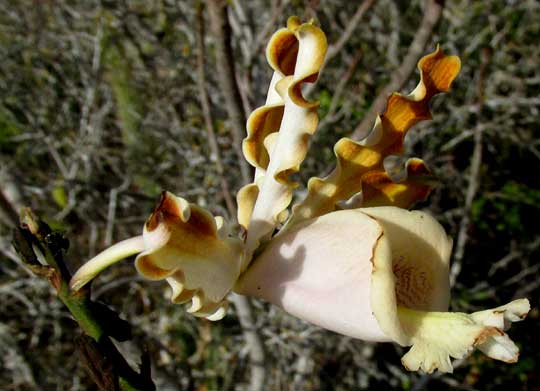
Myrmecophila christinae is known to occupy not only mangroves but also coastal dunes and sometimes-flooded areas with trees, as well as scrubby deciduous forest such as the thorn forest south of town. In fact, in the scrubby forest area between the mangroves and savanna/ranchland, the species is surprisingly common.
On one Myrmecophila christinae found in the thorn forest, what appeared to be ant-placed debris adhered to the flower-cluster peduncle all the way from the peduncle's base to the flower cluster. You can see it at the base in the picture below:

A picture of the debris among the flower clusters is shown below:

No mention of such debris on the peduncle's surface can be found in the literature, so maybe someday a researcher will be glad to see these last two pictures.

from the June 6, 2011 Newsletter issued from written at Mayan Beach Garden Inn 20 kms north of Mahahual; Caribbean coastal beach and mangroves, ~N18.89°, ~W87.64°, Quintana Roo state, MÉXICO
ORCHID FLOWERS TEN FEET HIGH
Here at the end of the long dry season much mangrove swampland is dry or at least has caked mud dry enough to walk on. In most places mangrove trees are so dense and entangled with one another that a human just can't get through them without cutting a path. Sometimes you find trails apparently cut by hunting or firewood-gathering locals and then you can penetrate the mangroves a little.
Inside one such mangrove a dead palm stump gave me a high perch for viewing the surrounding swamp. You can see my view across a sea of Red Mangrove above. In that picture if you look closely there are several clusters of white flowers atop slender, bamboo-like stems rising high above the mangrove. I tried to reach the flowers but the mangrove was too dense. I did get a little closer, though, so you can see what the flowering stems look like from inside the mangroves below:
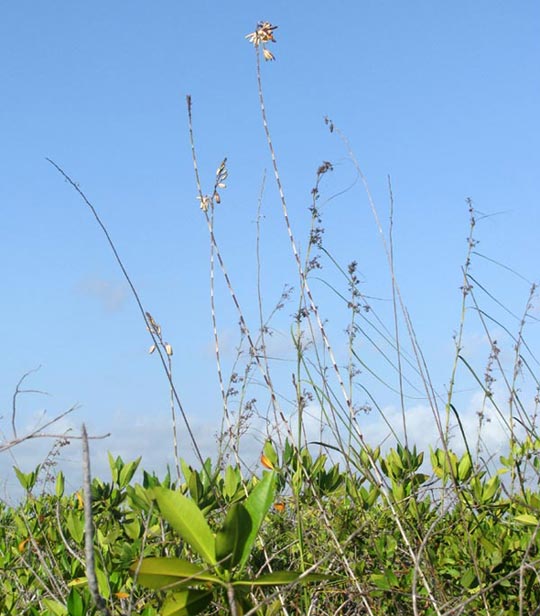
Happily the sunlight was intense so I could shoot at 1/1500th of a second, then in PhotoShop enlarge a tiny part of a high-resolution picture to get the shot shown below:

Once that image was on my laptop screen it was clear that we had an orchid! But who's heard of an orchid with stalks soaring ten feet high?
The best I can determine, this is the endangered orchid MYRMECOPHILA CHRISTINAE, endemic just to coastal Yucatán. It's a rare species first noted by science only in 1998. I'm taking pains to keep the plants' location secret because many orchid fanciers would pay big money for it, and drive a long way to rob it from its habitat.
In the flower picture, notice the ants. This orchid's pseudobulbs -- egglike, water-storing growths below the blades found in many orchid species -- are hollowed out so that they provide homes for ant colonies. The ants collect nectar and presumably protect the plant from herbivores who'd eat it.
The mangroves were so dense that I couldn't get close enough to the plants to see the leaves. However, I read that the plants grow epiphytically on mangrove stems and aerial roots. Thus I can't say how long the flowering stalks are, but judging from the arcs they made heaving in the wind I'd say that the stalks were at least eight feet long (2.4m), maybe ten (3m) or more.
What an honor to see this gorgeous plant, and what a pleasure to find it growing so lustily and healthily there deep in the mangroves.